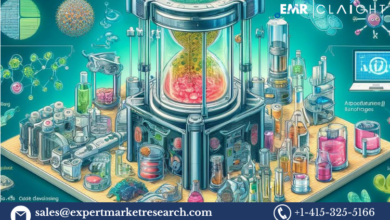Health
Exploring the Asia Pacific Biobanking Market: Trends, Growth Drivers, and Key Competitors in 2024

The biobanking market in the Asia Pacific is experiencing a surge in growth due to rising demand for personalized medicine, advancements in genomics, and increasing governmental and private sector investments. Biobanks are critical for preserving biological samples such as blood, tissues, and DNA, which are essential for medical research, diagnostics, and drug development. As of 2023, the market size is estimated at USD 72.1 billion and is expected to grow at a CAGR of 6.89% from 2024 to 2032, reaching USD 131.1 billion.
Key Market Drivers:
- Government and Private Investments: Governments across the Asia Pacific are funding biobanking projects as part of larger healthcare initiatives. Similarly, private companies and research institutions are heavily investing in biobanks to support research and development.
- Genomics and Precision Medicine: With a growing focus on personalized healthcare, biobanks are increasingly essential for genetic and genomic studies.
- Medical Research and Rare Disease Treatment: The demand for biobanking is also driven by the need to study rare diseases, stem cells, and regenerative medicine, as they provide crucial biological samples for research.
1. Market Dynamics and Growth Drivers
a. Key Growth Drivers in Detail
- Increased Investment in Healthcare Infrastructure: Countries like China, Japan, and South Korea are expanding healthcare infrastructure, including the establishment of biobanks, to facilitate advanced research in genomics and personalized medicine. This is part of broader health initiatives to improve healthcare outcomes and support innovative research.
- Focus on Genomics and Genetic Research: The growing importance of genomics in understanding diseases and developing tailored treatments is a significant driver for biobanking. Asia Pacific countries are increasingly participating in global genomics research, leveraging biobanks to study large population datasets.
- Advancements in Regenerative Medicine: Biobanks store critical samples for regenerative medicine research, including stem cell therapy. With a growing focus on personalized treatment, biobanks are positioned as central repositories for the biological materials needed for this cutting-edge medical field.
b. Challenges and Restraints
- Ethical and Regulatory Hurdles: Different countries have varying regulatory standards for biobanking, which can complicate operations, especially in regions with strict laws around genetic data.
- Operational Costs: Establishing and maintaining biobanks is capital-intensive, with costs associated with advanced storage equipment, staffing, and data management. This can limit the establishment of biobanks to well-funded organizations, affecting accessibility.
c. Opportunities
- Adoption of Automation and AI: There’s a growing trend towards automated sample handling and AI-driven data analysis, which helps reduce errors and improve sample management efficiency. This also opens up the potential for AI-based predictive analytics in research.
- Expansion into Emerging Markets: With developing countries in Asia Pacific increasing their healthcare budgets, there are opportunities for biobanks to establish new facilities and collaborate on research initiatives that cater to local healthcare needs.
d. Challenges
- Data Security and Integrity: Ensuring data security is a significant challenge for biobanks, especially with the sensitive nature of genetic data. Cybersecurity threats pose a risk to data integrity and privacy, making it crucial for biobanks to implement robust data protection measures.
- Navigating Diverse Regulatory Environments: With countries implementing their own biobanking regulations, it’s challenging for organizations operating across multiple regions to ensure compliance. Harmonizing these standards could be a future opportunity for the industry.
2. Trending Information in the Asia Pacific Biobanking Market
- AI and Automation: Biobanks are increasingly incorporating AI to enhance their operations. From managing large datasets to tracking samples in real-time, AI applications are helping biobanks streamline operations, minimize human error, and accelerate research outcomes.
- Digital Sample Tracking and IoT: Advanced IoT-enabled systems now allow biobanks to monitor and track samples digitally, ensuring accurate data and facilitating easier retrieval and use in research. This integration also supports secure data sharing among global research networks.
- Growth in Developing Nations: Emerging economies such as India and Indonesia are making strides in biobanking, fueled by government initiatives and collaborations with international research organizations. This growth signifies an increased focus on healthcare and research in these regions.
- Strategic Partnerships with Academia: Biobanks are collaborating with universities and research institutions for resource-sharing and knowledge exchange. This trend is promoting innovation and expanding research capabilities in genomics, rare diseases, and stem cell research.
3. Asia Pacific Biobanking Market Segmentation
a. By Type of Biobank
- Population-Based Biobanks: These biobanks store biological samples representing a broad population and are primarily used for public health research and epidemiological studies.
- Disease-Oriented Biobanks: Focusing on specific diseases, these biobanks are instrumental in research and drug development for targeted treatments and specialized studies.
b. By Sample Type
- Blood Products: Blood samples are one of the most stored samples in biobanks, useful in diagnostics, clinical studies, and genetic testing.
- Tissues and DNA: Tissue samples and DNA are crucial for understanding the molecular basis of diseases and developing targeted therapies.
- Stem Cells: Stem cell samples are widely used in regenerative medicine and are essential for advancing research in cell therapy and tissue engineering.
c. By Application
- Medical Research: Samples from biobanks are integral to medical research, providing the basis for studies on disease mechanisms and potential treatments.
- Drug Development: Biobanks collaborate with pharmaceutical companies, providing biological samples needed for drug discovery and testing.
- Diagnostics: Biobanks play a crucial role in developing diagnostic tools by providing high-quality, standardized biological samples.
4. Regional Insights and Competitive Landscape
a. Key Players and Their Strategies
- PHC Holdings Corporation: Focuses on partnerships to enhance biobanking capabilities, investing in digital solutions and automated storage systems.
- Thermo Fisher Scientific, Inc.: Known for its technological advancements, the company offers a comprehensive suite of biobanking products and solutions, including automation and data management.
- QIAGEN N.V.: Actively investing in research collaborations to strengthen its position in the market, focusing on sample storage and data analytics.
b. Patent Analysis
- Companies in the Asia Pacific biobanking market are increasingly filing patents related to innovative storage solutions, digital sample management, and advanced data protection technologies.
c. Grants and Funding
- Government grants are a significant funding source for biobanks in the region, especially in Japan, China, and South Korea. Private investment is also notable, particularly from biotech companies and research institutions.
d. Partnerships and Collaborations
- Strategic partnerships between biobanks and research institutions are on the rise, fostering data-sharing and collaborative research projects that accelerate biobanking and genomic research initiatives.
5. Future Outlook for the Asia Pacific Biobanking Market
- Market Growth and Projections: The Asia Pacific biobanking market is expected to grow significantly, driven by technological advancements, increased healthcare funding, and the rising prevalence of chronic diseases.
- Adoption of Big Data and AI: By 2032, biobanks are expected to widely adopt AI for data analysis and big data platforms for enhanced sample management and research capabilities.
- Focus on Sustainable Practices: As the healthcare industry moves towards sustainability, biobanks are adopting eco-friendly storage systems and incorporating practices that minimize environmental impact, aligning with global sustainability goals.





